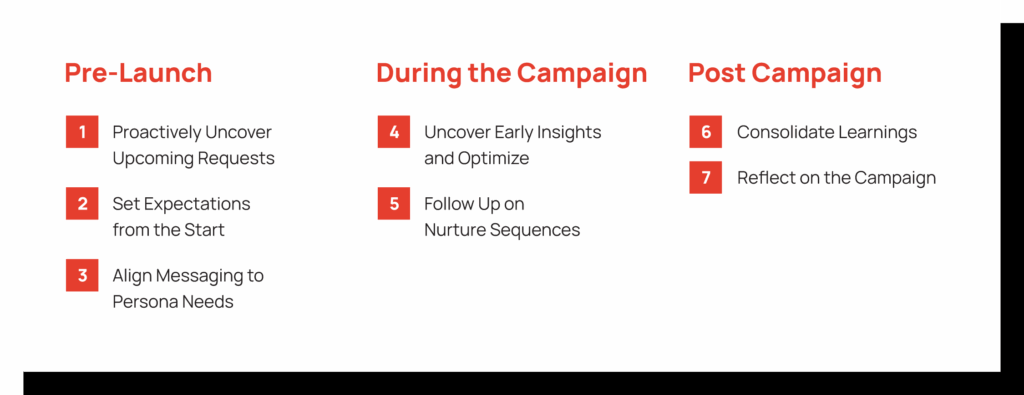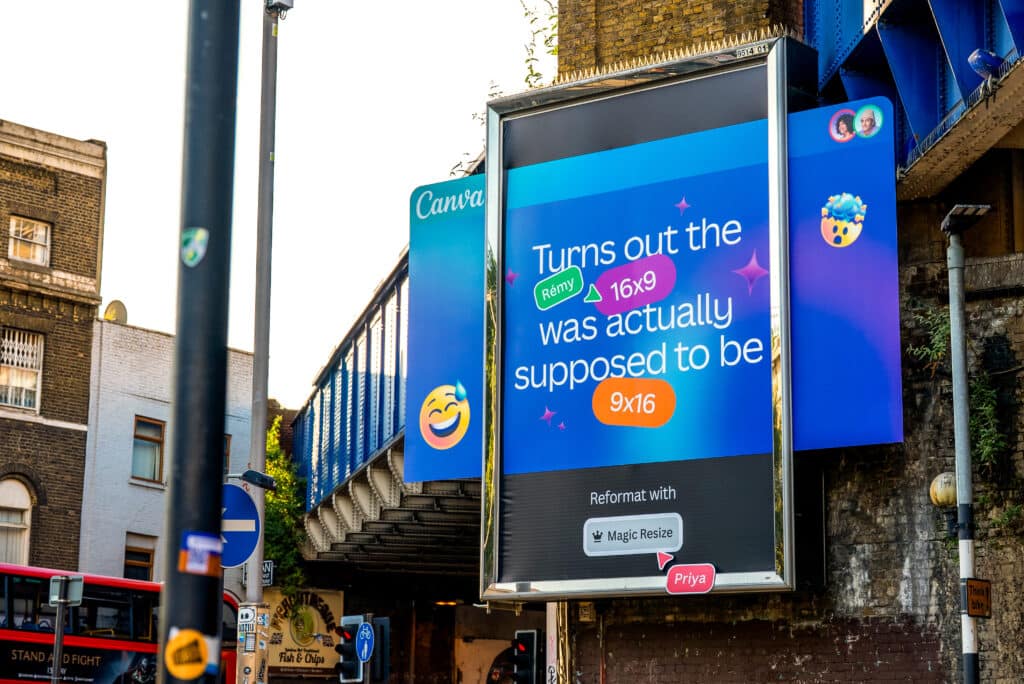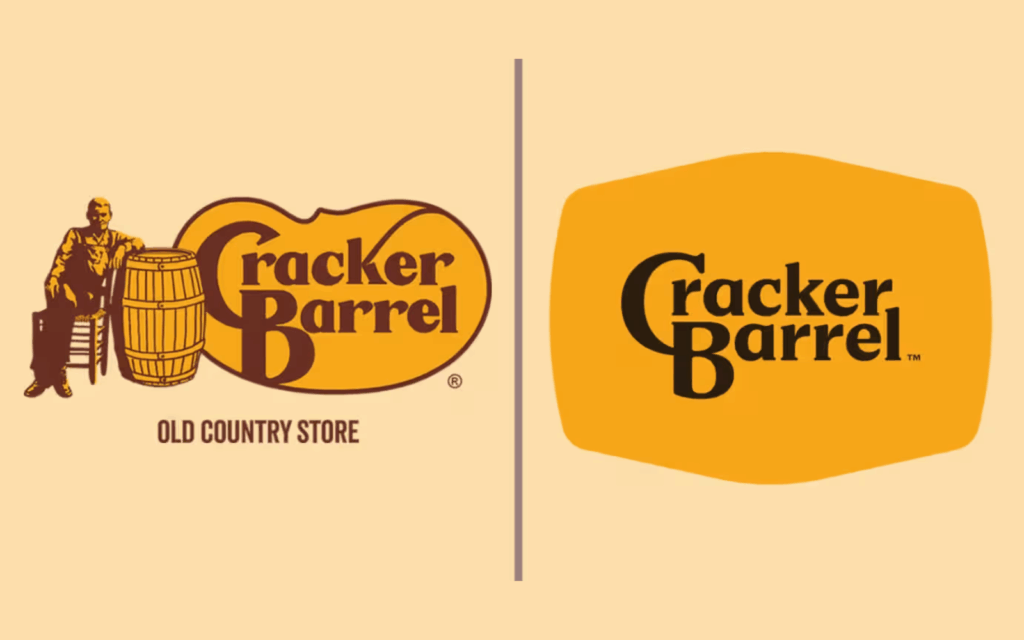Key Takeaways
A new marketing campaign is any initiative that sits outside of your always-on efforts. Unlike evergreen SEO, paid, or nurture programs, new campaigns are designed with a specific goal and a clear end date in mind.
This might mean spotlighting a product launch, rallying attention around a major industry event, or testing your messaging with a new audience segment. Sometimes it’s driven by leadership priorities, sometimes by seasonal opportunities, and sometimes by curiosity; the “let’s see what happens if we…” moments.
The point is: a new campaign should feel distinct from business as usual. It deserves its own planning, its own creative energy, and its own success criteria. Done well, a new marketing campaign can uncover insights that strengthen your always-on work for the long run.
In this article, we’ll walk through the full lifecycle of a new marketing campaign, from planning to launch to post-mortem, with practical tips you can apply right away. We’ll also share recent campaign wins worth learning from, along with a few cautionary tales of what not to do.

The biggest obstacle with new marketing campaigns is time. Get ahead of the curve by requesting a calendar of upcoming initiatives from key parties. Is your marketing team planning any events? Is the product team preparing for any new launches?
See if you can identify any patterns in past new marketing campaign requests. Do executive teams propose ideas in quarterly business reviews? Or do they follow up the week after the review with an idea that was sparked during the presentation?
Knowing what’s ahead will give you a significant advantage.
Because new marketing campaigns usually have different goals than always-on campaigns, ensure that everyone is on the same page about the campaign. Once a request comes your way, communicate timelines, required information, and what they can expect from you. Be clear about how long the platform will need to optimize the account and exit the learning period before you can report on concrete results.
Here are a few key pieces of information you should have documented in a campaign brief:
Pro tip: Keep your top-performing ads on instead of switching all spend to the new marketing campaign. Dramatically reducing budget or pausing ongoing efforts completely will halt conversions.
Companies often focus on products and features, while customers think in terms of pain points and benefits. Raise concerns early on and push back on messaging that contradicts what you’ve already learned about your audience. Bonus points if you have documented A/B test data that can back up your claims.
Consider workshopping campaign messaging and design concepts with key stakeholders before sending the copy over for final design. There are lots of eyes on the creative for one-off campaigns and you usually need approval for multiple individuals. There’s nothing worse than thinking you’ve wrapped a project up only to have three additional rounds of back-and-forth revisions.
The campaign is launched, but you’re not done yet! Dive into the performance data and see which ad creatives are resonating the best. Pause low-performing ads and make adjustments to improve performance. What learnings can you report on?
When you filled out the new campaign brief, you should have discussed how you were going to follow up with audiences from the one-off campaign. If a retargeting campaign isn’t already in action, it’s time to get that up and running. Don’t let too much time go by between audience interactions with your newly born marketing campaign and the next touchpoint.
After the campaign has ended, debrief and put all of your learnings into a single location for easy reporting and future reference.
A few things to include:
Since another new marketing campaign is likely to come your way again, take time to reflect on the campaign. Is there anything you would do differently? Loop in the person who requested the campaign. Did they get the information they hoped to gain? Were the results what they expected?
Finally, evaluate the overall effectiveness of the campaign. If similar initiatives arise in the future, would you expect them to succeed? Should you push back on this type of campaign moving forward or double down on your efforts?
Try out these seven steps the next time a campaign request comes your way. Instead of rushing to push something out the door, you’ll have a process in place that adds genuine value to your organization.
Every marketer’s been asked for “examples of campaigns that worked.” We won’t be the first to say it; success rarely comes from one magic trick. It comes from understanding your audience, telling a story they actually care about, and being willing to take risks when it counts.
Here are three recent campaigns that got it right, for very different reasons.
When American Eagle tapped Sydney Sweeney for their denim ads, they didn’t play it safe. The campaign headline “Sydney has great jeans” sparked immediate buzz, equal parts clever wordplay and eyebrow-raising innuendo.
Critics weighed in, competitors like Gap and Lucky Brand jumped into the conversation, and suddenly American Eagle was winning attention far outside their usual channels.

Our takeaway: Sometimes controversy is the strategy. But, pulling it off takes confidence in your brand voice, a readiness for backlash, and a clear plan to capture the upside of all that attention.
While most AI brands fight for attention with speed, disruption, and hype, Anthropic zagged. Their “Keep thinking” campaign positioned Claude as thoughtful, safe, and human-aligned.
It was quiet where others were loud, reflective where others were flashy, and it worked. Anthropic found white space between its competitors and used brand values as the creative hook.

Our takeaway: A campaign grounded in authenticity can be more disruptive than the most over-the-top creative. Values resonate, especially when the rest of the industry is running in the opposite direction.
Canva didn’t do a campaign telling people its tools are great to use; it showed them. Their billboard takeover at London’s busiest train station literally demonstrated product features: background removal, drag-and-drop edits, and clean design transformations.
Commuters stopped. Photos spread online. The product explained itself in 20 seconds flat, and people remembered Canva for it.

Our takeaway: The best campaigns make the product the star, not by listing features, but by proving value in a way that’s impossible to ignore.
Not every new campaign makes headlines for the right reasons. Some fall flat, some spark backlash, and some quietly get walked back before anyone notices. But even the flops have value. They remind us what not to do and why strategy matters as much as creativity.
Here are two recent examples that prove the point.
Cracker Barrel spent big to modernize its brand, all the way from its logo to the interior of its restaurants. The goal was to broaden appeal and refresh the experience for a new generation of diners.
The problem? Longtime customers didn’t want a new Cracker Barrel. They wanted the one they already loved. By removing nostalgic elements, the rebrand sparked anger among loyalists. Traffic dropped, sentiment soured, and within a month, the company had to backpedal.

Our takeaway: Brand equity is emotional equity. Before making sweeping changes, test your ideas, phase your rollout, and make sure you’re not alienating the very people who built your business.
Jaguar’s recent push into ultra-luxury electric vehicles was bold. New visuals, a “hot pink” launch campaign, and a decision to discontinue lower-end models made it clear the brand was chasing a different audience.
The reaction was mixed at best. Traditional customers felt alienated, critics mocked the visuals, and even fans admitted the pivot was jarring. Still, Jaguar has doubled down, betting the long-term payoff will outweigh the early backlash.

Our takeaway: Repositioning is sometimes necessary, but it’s a long game. If you’re going to risk alienating part of your base, you need crystal clarity on who you’re speaking to, why it matters, and how you’ll sustain momentum through the pushback.
Launching a new marketing campaign isn’t easy, but it doesn’t have to feel like starting from scratch every time. With the right foundation, clear messaging, smart use of data (and yes, AI), and a commitment to learning from every run, campaigns can do more than hit short-term goals. They can make your always-on marketing stronger, too.
Every campaign, big or small, is an opportunity to sharpen your strategy, experiment with creative, and uncover what your audience responds to. The wins matter. The misses matter too. The real advantage comes from teams who take the time to reflect and apply those lessons to what’s next.
At 97th Floor, we build marketing campaigns that create momentum and generate the results you're looking for. If you're ready to see what Great Marketing can do for your brand, lets build.
Start by deciding if the campaign is about awareness, conversions, or testing a new audience. Your objective shapes everything else, including messaging, creative, channel mix, and metrics.
Build in more time than you think. Creative, approvals, and testing always take longer than expected. Even a “fast” campaign benefits from a buffer to avoid rushed messaging or sloppy execution.
Your best insights come from the data you already own, like past campaigns, surveys, and customer feedback. Use these signals to refine targeting and messaging instead of starting from scratch.
It’s rarely just one. Paid, organic, and social often perform best in combination. The key is finding overlap without cannibalizing what’s already working in your always-on campaigns.
Track more than reach. Look at conversions, cost per acquisition, CTRs, and which creative actually resonates. Post-campaign, capture learnings that can strengthen your always-on efforts.
Every new marketing campaign should include space for pilots or soft launches. Small tests expose problems and surface insights before you scale, saving money and frustration later.

